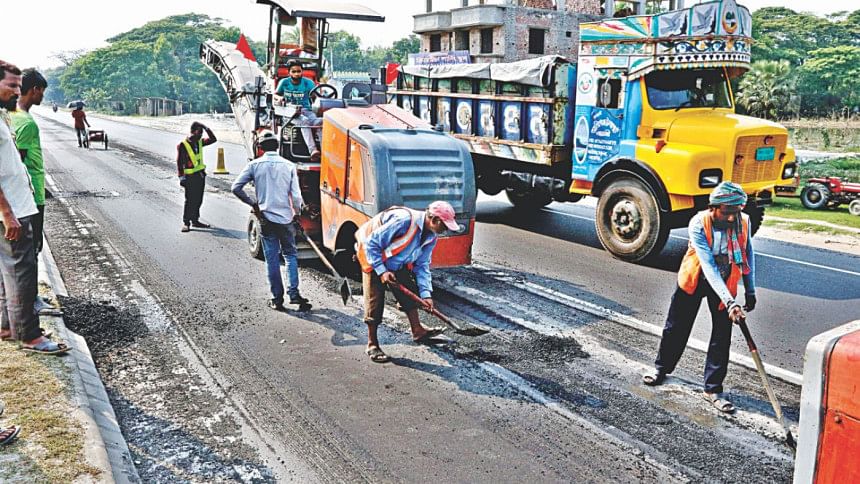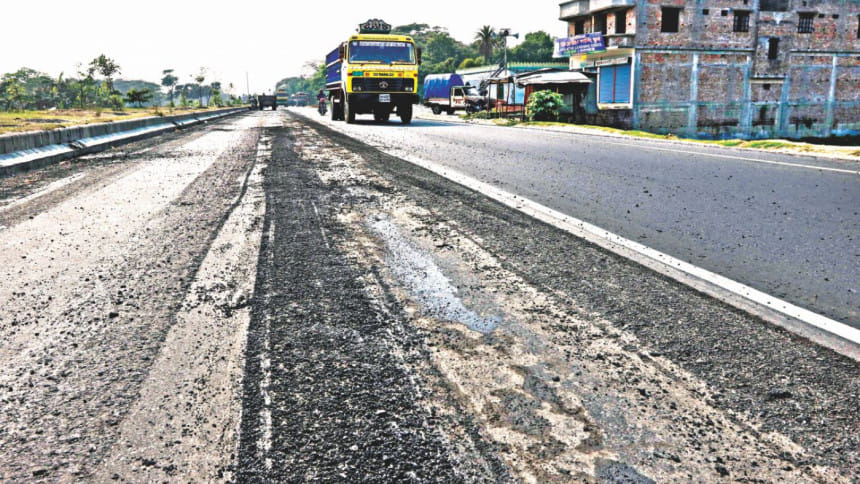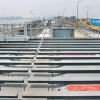4-Lane Dhaka-Ctg Highway: Up for mending all too soon


Mohammad Bachchu was intensely looking at the milling machine cutting ruts on the Dhaka-Chittagong highway at Nooritola of Chandina on Tuesday afternoon. This way, the highway is being made usable somehow.
"I never thought we would require cutting the road surface so soon,” said Bachchu, who was involved in the original expansion work of the highway. The project cost the taxpayers Tk 3,600 crore.
An employee of the project's Chinese contractor Sino-Hydro that expanded 140km of the 192km highway, Bachchu was hired by the Roads and Highways Department (RHD) to supervise the rut-cutting job.
The RHD also hired two milling machines from Sino-Hydro for the job.
The rut cutting began much earlier though. As the long, deep track made by the repeated passage of vehicles began to develop within months after the expansion work ended in December 2016, Sino-Hydro itself cut them from several kilometers of the road.
The company left in June 2017 on expiry of the defect-liability period.
The road transport and bridges ministry is now seeking Tk 900 crore for maintenance in the next five years, ministry officials said.
For now, the RHD is fixing the damage temporarily, which will require Tk 10 crore.
The RHD began the mending job in Chittagong zone in November and it continued till January. In Comilla zone, the work began in February.
“It will take us one and a half months to complete the job in Comilla zone,” said Bachchu, adding that it took a day to cut ruts on one kilometre road.
The condition of the road in Feni is among the worst as the RHD could not work there for shortage of milling machines, according to RDH officials.
Experts say new roads remain in good shape for four to five.
On Tuesday, this reporter took a round trip on the highway and found ruts on the road mile after mile. At some places, the road is so bumpy that drivers have to be extra caution to avoid accident.
RHD engineers and ministry officials who were involved with the project now squarely blame overloaded vehicles for the condition of the highway, known as the economic lifeline of Bangladesh. This highway is responsible for carrying 90 percent of the export and import volume.
Though the ministry is seeking more funds for the mending job, it did not engage any experts to determine the causes of the ruts in such a short time.
"Plying of overloaded vehicles cannot be controlled. As a result, the road is developing ruts,” claimed RHD Chief Engineer Ibne Alam Hasan, despite the fact that there is a machine in Sitakunda to check overloading.

Asked how he drew the conclusion when no examination was done by independent experts, Alam said, "There may be multiple reasons but overloading is the main."
Alam, who was director of the expansion project, said the ministry discussed the problem several times and decided to go for continuous repair work.
A senior official of the ministry said the expansion work should have been thoroughly investigated before allocating fresh funds for the repair job.
“We do not know if there is negligence or wrongdoings by contractors,” the official said.
Bachchu, who is doing asphalt work for 20 years, blamed the high thickness of the “wearing course” (the upper layer of a bituminous broad) and excessive bitumen for the ruts.
“The thickness of the wearing course on the highway is higher than that on other roads. For this additional bitumen, the surface may be failing to hold the bottom layer,” he said.
Also, the bitumen grade for the highway was 60-70, which cannot stand overloading.
Alam said 60-70 grade bitumen was standard for the country. "Buet experts approved the specification and we followed it.”
Asked if the grade was appropriate for the Dhaka-Chittagong highway, he insisted that it was a standard practice in Bangladesh and worldwide and it could not be changed.
But a senior official of the road ministry said, “During the expansion work, they could have checked if the standard was appropriate because we all know overloaded vehicles ply the road,”
There must have been an alternative, he added.
Locals and drivers, who are critical about the quality of the work, blame the authorities for their failure to check overloading.
HAZARDOUS DRIVING
As a result of the damage, driving on the highway is difficult and dangerous.
"I struggle to control my vehicle when I drive at high speed and change lanes," said Dulu Mia, a trucker.
Fazar Ali, who has been driving different modes of transports for 38 years, has a similar experience. "The road is so uneven at some points that I struggle to remain in my seat."
Often, frequent road crashes claimed lives on the narrow but the busiest highway and so its expansion was badly needed both for faster communications and saving lives. Tailbacks were a daily phenomenon on the road, hampering export and import through Chittagong Port.
The project was initiated during the BNP-led government in September 2006. It was finalised in 2010, a year after the Awami League took office.
But it turned out to be the most talked-about project after the Padma bridge because of the government's inability to supervise the project.
Construction works never got momentum for various reasons. As a result, a three-year project took six years and the cost more than doubled.
The biggest weakness of the project was the government's giving in to the demand of Sino-Hydro for additional fund.
Reza Constructions Ltd and Taher Brothers Ltd were the two other contractors.

 For all latest news, follow The Daily Star's Google News channel.
For all latest news, follow The Daily Star's Google News channel. 








Comments